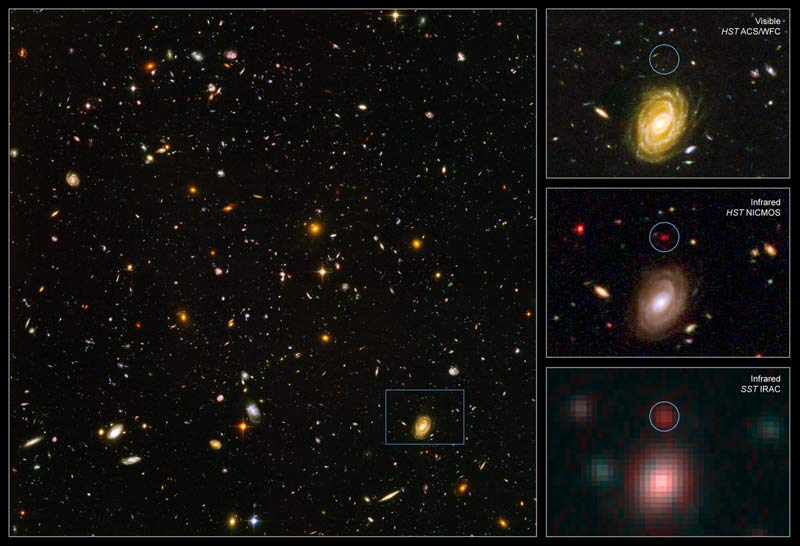Massive Distant Galaxy Calls Theory into Question

One of the most distant galaxies ever studied is more massive and mature than expected, astronomers announced today. The finding suggests some galaxies grew up much more quickly than conventional wisdom held.
The galaxy, named HUDF-JD2, is seen as the universe was only about 800 million years old. The universe today is about 13.6 billion years old.
"This galaxy appears to have 'bulked up' amazingly quickly, within a few hundred million years after the Big Bang," said Bahram Mobasher of the European Space Agency and the Space Telescope Science Institute. "It made about eight times more mass in terms of stars than are found in our own Milky Way today, and then, just as suddenly, it stopped forming new stars. It appears to have grown old prematurely."
The galaxy was spotted in an infrared image made last year as part of the Hubble Space Telescope's Ultra Deep Field survey. Follow-up observations were done with NASA's Spitzer Space Telescope and the European Southern Observatory's Very Large Telescope.
Spitzer records infrared light at wavelengths longer than what Hubble sees, making it better at spotting older, redder stars. These old stars in the galaxy are the clues to its overall maturity.
The leading theory of galaxy formation holds that small galaxies merged to gradually form larger ones. But the newfound galaxy is so massive at such an early epoch that astronomers now think that at least some galaxies formed more quickly in a monolithic manner.
Other recent observations have begun to reveal similar disparities between theory and reality.
Get the Space.com Newsletter
Breaking space news, the latest updates on rocket launches, skywatching events and more!
"This would be quite a big galaxy even today," said study team member Mark Dickinson of the National Optical Astronomy Observatory. "At a time when the Universe was only 800 million years old, it's positively gigantic."
The galaxy likely harbors a supermassive black hole at its center, the astronomers said. In recent years, black holes have been seen as a crucial element in the formation and evolution of galaxies, but theorists are still unsure of the exact details of how it all comes together.
Full caption for the images:
The galaxy HUDF-JD2 was found among approximately 10,000 others in a small area of sky called the Hubble Ultra Deep Field (HUDF). This is the deepest images of the universe ever made at optical and near-infrared wavelengths.
Upper Right: A blow-up of one small area of the HUDF is used to identify where the distant galaxy is located (inside green circle). This visible-light image does not show the galaxy, indicating that its visible light has been absorbed by traveling billions of light-years through intervening hydrogen.
Center Right: The galaxy was detected using Hubble's Near Infrared Camera and Multi-Object Spectrometer (NICMOS). But at near-infrared wavelengths it is very faint and red.
Bottom Right: The Spitzer Infrared Array Camera (IRAC), easily detects the galaxy at longer infrared wavelengths. Spitzer's IRAC is sensitive to the light from older, redder stars, which should make up most of the mass in a galaxy. The brightness of the infrared galaxy suggests that it is quite massive.
- All Galaxies to Become Ghosts, Frozen in Time and Space
- Our Tangled Universe: How the First Galaxies Were Born
- Cosmic Fossils Show Milky Way Is a Galaxy Gobbler
Join our Space Forums to keep talking space on the latest missions, night sky and more! And if you have a news tip, correction or comment, let us know at: community@space.com.

Rob has been producing internet content since the mid-1990s. He was a writer, editor and Director of Site Operations at Space.com starting in 1999. He served as Managing Editor of LiveScience since its launch in 2004. He then oversaw news operations for the Space.com's then-parent company TechMediaNetwork's growing suite of technology, science and business news sites. Prior to joining the company, Rob was an editor at The Star-Ledger in New Jersey. He has a journalism degree from Humboldt State University in California, is an author and also writes for Medium.









